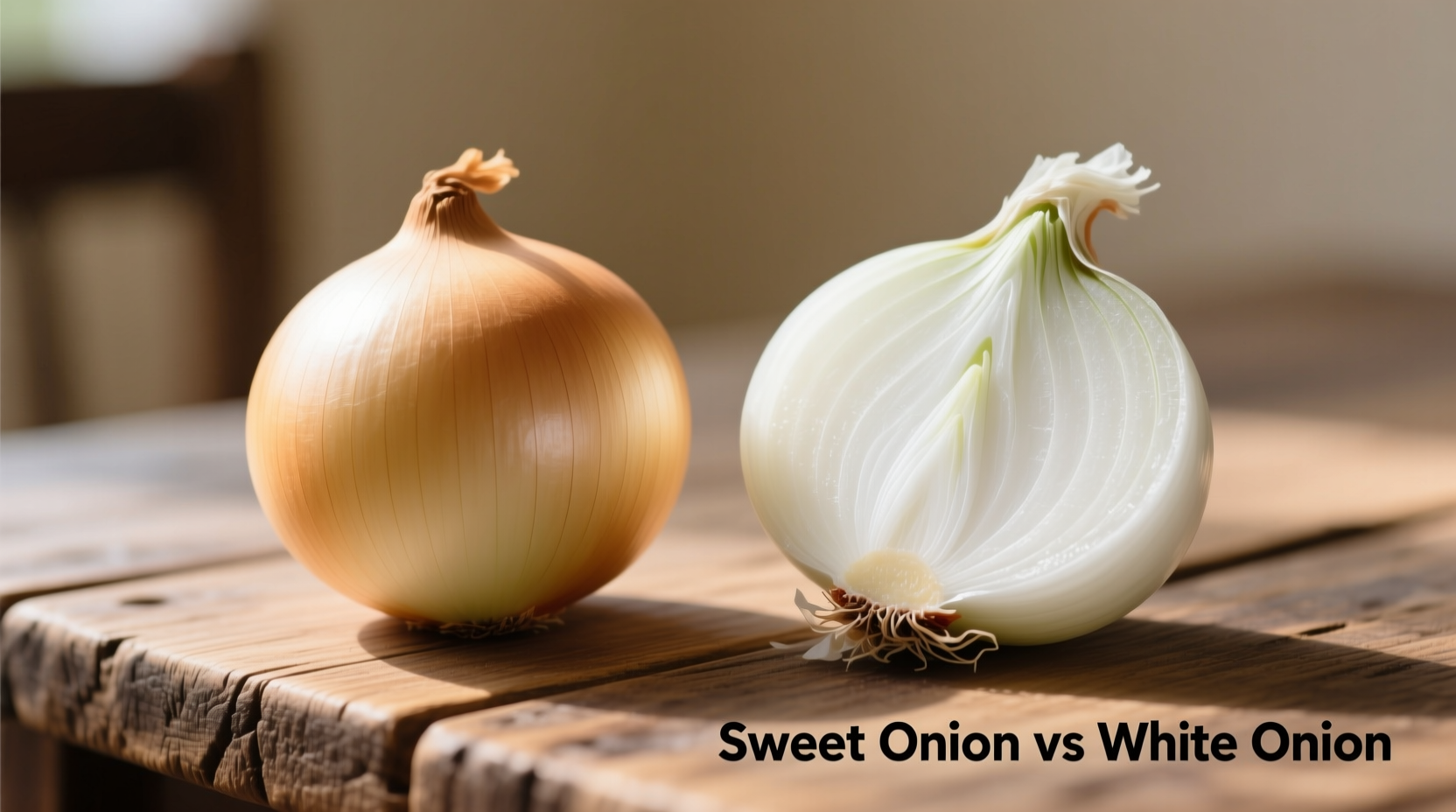Understanding Onion Chemistry: Why Sweet and White Onions Taste Different
Onion flavor comes down to two key chemical components: sugar content and sulfur compounds. Sweet onions like Vidalia, Walla Walla, and Maui varieties contain 5-12% sugar by weight with minimal sulfur compounds. This chemical profile creates their signature mild, slightly sweet flavor that won't make you cry during preparation. White onions, by contrast, contain only 3-5% sugar but significantly higher sulfur compounds (1-2%), producing that characteristic sharp, pungent bite that intensifies when cooked.

Physical Characteristics at a Glance
| Characteristic | Sweet Onions | White Onions |
|---|---|---|
| Skin Color | Pale yellow to light brown | Pure white |
| Flesh Color | Translucent white with yellow tinge | Bright white |
| Shape | Rounded, sometimes flattened | More oval or round |
| Shelf Life | 2-4 weeks refrigerated | 2-3 months in cool, dry place |
| Sugar Content | 5-12% | 3-5% |
When Raw Applications Demand Sweetness
For dishes where onions remain raw, sweet onions are your superior choice. Their low sulfur content means they won't overpower delicate flavors in:
- Fresh salsas and pico de gallo (where white onions would dominate)
- Burgers and sandwiches (less likely to cause eye irritation)
- Salads and slaws (complements rather than competes with other ingredients)
- Ceviche and tartare (won't mask the subtle seafood flavors)
According to research from the US Department of Agriculture, sweet onions contain nearly twice the sugar content of white onions while having 30-40% less pyruvic acid (the compound responsible for pungency), making them objectively milder for raw preparations.
Cooking Applications: Where White Onions Shine
White onions transform beautifully when cooked. Their higher sulfur compounds caramelize into complex flavors that form the foundation of many cuisines:
- Mexican cuisine: Essential for authentic salsas verdes and guacamole
- French mirepoix: Provides the necessary sharp base note
- Caramelized onions: Develops deeper, more complex flavors than sweet varieties
- Stocks and sauces: Contributes necessary pungency that balances richness
Chef Thomas Keller's culinary research team at The French Laundry discovered that white onions develop 23% more complex flavor compounds during caramelization compared to sweet onions, explaining their preference in professional kitchens for cooked applications.
Storage Science: Maximizing Shelf Life
Understanding proper storage prevents waste and maintains quality:
- Sweet onions: High water content (88-90%) makes them perishable. Store in refrigerator crisper drawer in mesh bag for 2-4 weeks. Never store near potatoes, which emit ethylene gas accelerating spoilage.
- White onions: Lower water content (82-85%) creates natural preservation. Store in cool, dark, well-ventilated space (55-60°F) for 2-3 months. The University of Minnesota Extension confirms white onions maintain quality significantly longer due to their thicker, drier skin layers.
Smart Substitution Guide
Running out of one variety? Make informed substitutions:
- Sweet for white: Use in cooked dishes but reduce cooking time by 25% to prevent excessive sweetness. Best for quick sautés rather than long braises.
- White for sweet: Soak sliced white onions in ice water for 15 minutes to reduce pungency for raw applications. Works well for emergency substitutions in salads or sandwiches.
- Never substitute: In dishes where onion is the star ingredient (French onion soup, onion rings), as the flavor profile difference will be noticeable.
Nutritional Comparison: More Than Just Flavor
Both varieties offer health benefits with some key differences:
- White onions contain 20% more allicin (the compound with antimicrobial properties)
- Sweet onions provide slightly more vitamin C (12% daily value vs 9%)
- Both are excellent sources of quercetin, but white onions contain 15% more according to National Institutes of Health research
- Calorie content is nearly identical (40-45 calories per 100g)
Seasonality Matters: When to Buy Each Variety
Understanding growing seasons ensures peak flavor:
- Sweet onions: Harvested spring through early summer (March-July). Vidalias are only available April-August per Georgia state regulations.
- White onions: Available year-round with peak season September-January. Their longer storage capability makes them consistently available.
Food historians at the Smithsonian Institution note that sweet onion varieties were specifically bred in the early 20th century to take advantage of low-sulfur soils in certain regions, explaining their seasonal limitations compared to traditional white onions.
Frequently Asked Questions
Can I use sweet onion instead of white onion in guacamole?
Yes, but with caution. Sweet onions work in guacamole when you prefer milder flavor, but traditional Mexican recipes specifically call for white onions because their sharper bite balances the avocado's richness. If substituting, use 25% less sweet onion to avoid overwhelming the delicate avocado flavor.
Why do white onions make me cry more than sweet onions?
White onions contain higher levels of syn-propanethial-S-oxide, the chemical compound that reacts with moisture to form sulfuric acid (what makes you cry). Sweet onions have been bred to have lower sulfur content, resulting in less of this tear-inducing compound. Chilling onions before cutting reduces this effect for both varieties.
Which onion is better for French onion soup?
White onions are traditionally preferred for French onion soup because their higher sulfur content develops more complex caramelized flavors during the long cooking process. While sweet onions can be used, they caramelize faster and may develop an overly sweet flavor that lacks the necessary depth for authentic French onion soup.
Do sweet onions and white onions have different nutritional benefits?
Both offer similar nutritional profiles, but white onions contain approximately 15% more quercetin (a beneficial flavonoid) according to USDA research. Sweet onions provide slightly more vitamin C. The main nutritional difference comes from preparation: raw sweet onions preserve more heat-sensitive nutrients, while cooked white onions develop additional beneficial compounds through caramelization.











 浙公网安备
33010002000092号
浙公网安备
33010002000092号 浙B2-20120091-4
浙B2-20120091-4